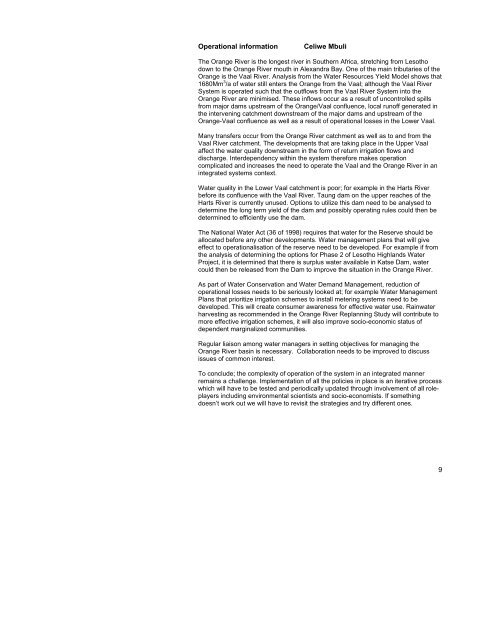An integrated assessment of socio-economic and ... - Unesco
An integrated assessment of socio-economic and ... - Unesco
An integrated assessment of socio-economic and ... - Unesco
Create successful ePaper yourself
Turn your PDF publications into a flip-book with our unique Google optimized e-Paper software.
Operational information Celiwe Mbuli<br />
The Orange River is the longest river in Southern Africa, stretching from Lesotho<br />
down to the Orange River mouth in Alex<strong>and</strong>ra Bay. One <strong>of</strong> the main tributaries <strong>of</strong> the<br />
Orange is the Vaal River. <strong>An</strong>alysis from the Water Resources Yield Model shows that<br />
1680Mm 3 /a <strong>of</strong> water still enters the Orange from the Vaal; although the Vaal River<br />
System is operated such that the outflows from the Vaal River System into the<br />
Orange River are minimised. These inflows occur as a result <strong>of</strong> uncontrolled spills<br />
from major dams upstream <strong>of</strong> the Orange/Vaal confluence, local run<strong>of</strong>f generated in<br />
the intervening catchment downstream <strong>of</strong> the major dams <strong>and</strong> upstream <strong>of</strong> the<br />
Orange-Vaal confluence as well as a result <strong>of</strong> operational losses in the Lower Vaal.<br />
Many transfers occur from the Orange River catchment as well as to <strong>and</strong> from the<br />
Vaal River catchment. The developments that are taking place in the Upper Vaal<br />
affect the water quality downstream in the form <strong>of</strong> return irrigation flows <strong>and</strong><br />
discharge. Interdependency within the system therefore makes operation<br />
complicated <strong>and</strong> increases the need to operate the Vaal <strong>and</strong> the Orange River in an<br />
<strong>integrated</strong> systems context.<br />
Water quality in the Lower Vaal catchment is poor; for example in the Harts River<br />
before its confluence with the Vaal River. Taung dam on the upper reaches <strong>of</strong> the<br />
Harts River is currently unused. Options to utilize this dam need to be analysed to<br />
determine the long term yield <strong>of</strong> the dam <strong>and</strong> possibly operating rules could then be<br />
determined to efficiently use the dam.<br />
The National Water Act (36 <strong>of</strong> 1998) requires that water for the Reserve should be<br />
allocated before any other developments. Water management plans that will give<br />
effect to operationalisation <strong>of</strong> the reserve need to be developed. For example if from<br />
the analysis <strong>of</strong> determining the options for Phase 2 <strong>of</strong> Lesotho Highl<strong>and</strong>s Water<br />
Project, it is determined that there is surplus water available in Katse Dam, water<br />
could then be released from the Dam to improve the situation in the Orange River.<br />
As part <strong>of</strong> Water Conservation <strong>and</strong> Water Dem<strong>and</strong> Management, reduction <strong>of</strong><br />
operational losses needs to be seriously looked at; for example Water Management<br />
Plans that prioritize irrigation schemes to install metering systems need to be<br />
developed. This will create consumer awareness for effective water use. Rainwater<br />
harvesting as recommended in the Orange River Replanning Study will contribute to<br />
more effective irrigation schemes, it will also improve <strong>socio</strong>-<strong>economic</strong> status <strong>of</strong><br />
dependent marginalized communities.<br />
Regular liaison among water managers in setting objectives for managing the<br />
Orange River basin is necessary. Collaboration needs to be improved to discuss<br />
issues <strong>of</strong> common interest.<br />
To conclude; the complexity <strong>of</strong> operation <strong>of</strong> the system in an <strong>integrated</strong> manner<br />
remains a challenge. Implementation <strong>of</strong> all the policies in place is an iterative process<br />
which will have to be tested <strong>and</strong> periodically updated through involvement <strong>of</strong> all roleplayers<br />
including environmental scientists <strong>and</strong> <strong>socio</strong>-economists. If something<br />
doesn’t work out we will have to revisit the strategies <strong>and</strong> try different ones.<br />
9
















